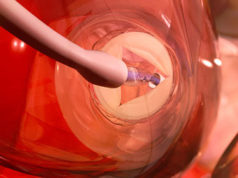
QT Vascular and its subsidiaries have announced the release of the initial results from the first-in-human (FIH) study of its unique drug-coated balloon, Chocolate Heart.
The initial acute and 30 days outcomes of the Chocolate Heart FIH study were presented at the 2015 Transcatheter Cardiovascular Therapeutics conference (TCT), held in San Francisco. Jihad Mustapha of Metro Hospital in Wyoming, Michigan, presented the data, which showed promising results in a group of 19 patients with de novo coronary disease, for the Chocolate Heart.
Procedural Outcomes:
Incidence
Bail-out (unplanned) stent placement
0% (0/19)
Significant dissection
0% (0/19)
Abrupt closure
0% (0/19)
Sub-acute occlusion
0% (0/19)
30 day Outcomes
Incidence
Death
0% (0/18)
Myocardial infarction
0% (0/18)
Target lesion revascularisation
0% (0/18)
Overall major adverse cardiac events (MACE)
0% (0/18)
“While this is an early feasibility study and larger confirmatory studies will be needed, these preliminary results are very encouraging as they hint at the possibility of being able to offer an effective treatment to patients with de novo coronary disease without the use of a permanent implant, such as a metallic stent or a bioresorbable scaffold, which may take years to dissolve”, states Bruno Scheller of the University of Saarland in Homburg/Saar, Germany. “The gentle dilatation of the Chocolate platform may account for these excellent early outcomes. I am looking forward to seeing the mid- and long-term outcomes with this unique device.”
At the 6 month follow up time point, the core-lab adjudicated average late lumen loss (LLL) in the first 15 patients was only 0.02mm. Consistent with this low average LLL, only a single patient required an additional procedure at the treated site. “We are delighted with these results as they are consistent with the outcomes of drug-coated Chocolate in peripheral vessels,” comments Eitan Konstantino, chief executive officer of QT Vascular. “The low trauma mechanism of the Chocolate platform combined with our proprietary paclitaxel coating may offer some patients suffering from coronary artery disease an alternative to the placement of metallic stents or bioresorbable scaffolds.”
The Chocolate Heart FIH study is a single-centre, feasibility study conducted at CECANOT Hospital in Santo Domingo, Dominican Republic for up to 30 patients with symptomatic, de novo coronary disease. The primary endpoint is target lesion late lumen loss at 6 months (to be assessed by the independent angiographic core lab at Yale University). Secondary endpoints include device, lesion, and procedural success, abrupt closure, threatened closure, and the cross-over rate to stenting due to unsuccessful angioplasty. Patients will also undergo intra-vascular ultrasound (IVUS) assessment at 6 months (reviewed by the independent IVUS core lab at Cardiovascular Research Center in Sao Paolo, Brazil).
Drug-coated PTA balloons devices have been available for several years in Europe and were recently approved in the USA. Since their approval in the USA, adoption has been increasing and CMS (Centers for Medicare and Medicaid Services) has granted additional reimbursement for these devices. According to some analyst estimates, revenues for drug-coated balloons are expected to reach $1 billion by 2020.
The QT Vascular Chocolate Touch Drug Coated Peripheral Balloon received CE mark approval in July 2015. Commercial launch of Chocolate Touch in countries that are accepting CE mark will commence early this year. The product is not approved for use in the United.










